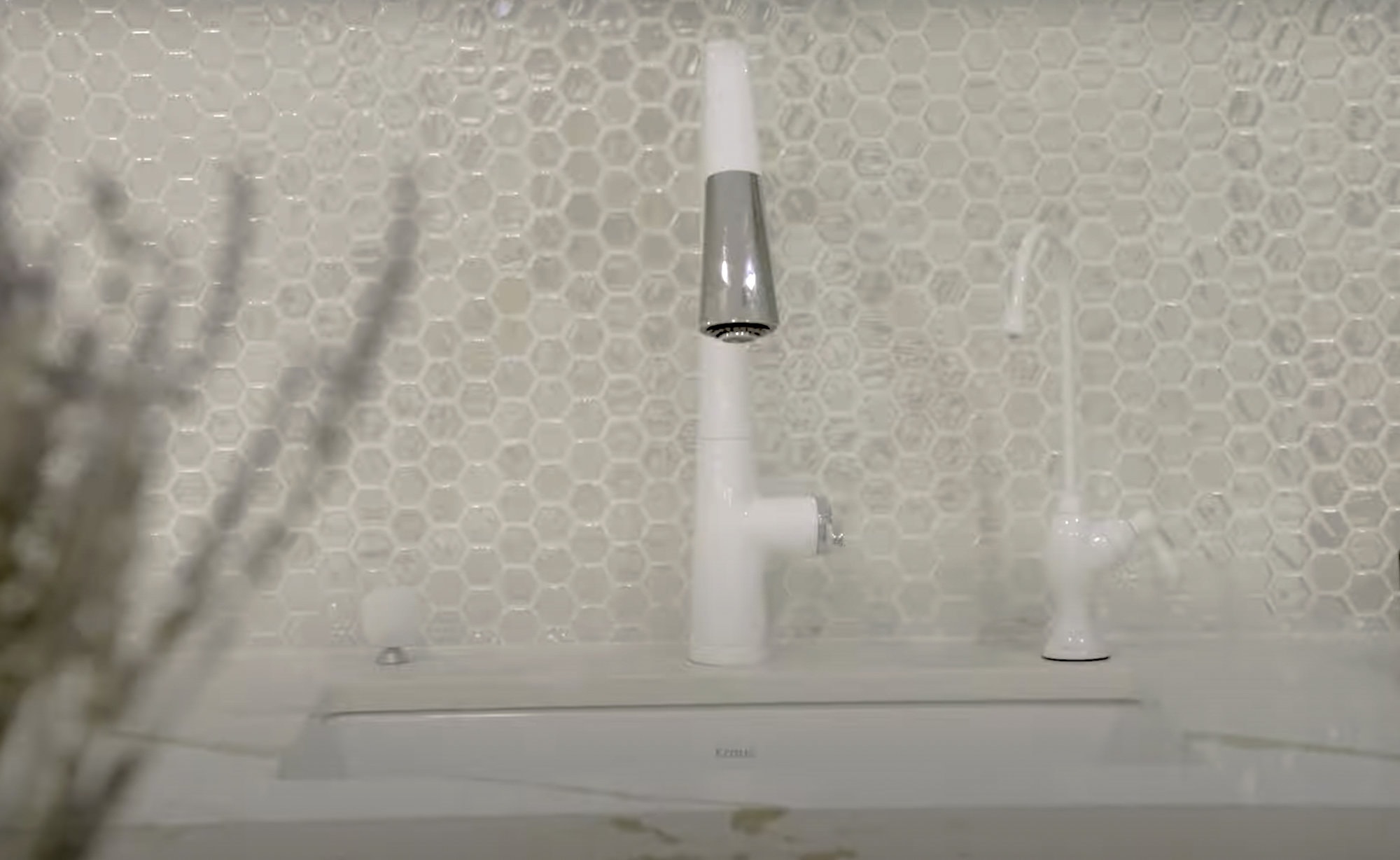If you’ve watched me over the years, you know I’m big on one thing: doing it right. That doesn’t just apply to how you build or renovate a home...

How To Choose The Best Reverse Osmosis (RO) Water System
By Mike Holmes
Mike’s Advice / Buying & Selling Your Home
Tuesday, June 21st, 2022 @ 10:04pm
A Guide to Improving Your Water Quality With A Reverse Osmosis (RO) Water System
I am on a well system. I was noticing some visible issues like cloudy water and caking around my shower head, but I also FELT that my water quality was poor when I showered. So I tested my water. The results weren’t looking good the first time, so I dug a new well before testing my water again. Let me tell you I learned A LOT about the process of improving water quality, especially Reverse Osmosis (RO) systems.
I remember one day when I picked up my cup of coffee and it looked like the cloudiest water I’ve ever seen. My mind was thinking, ok you are a contractor, you can drink this. But that wasn’t right. I needed to understand what was in my water and have a water treatment system installed which is what I did.
I had a whole home water filtration system installed by the Kinetico water professionals which included a Premier Series water softener and a Reverse Osmosis (RO) system, the K5 Drinking Water Station. I am a big fan of RO water myself because it removes just about all the contaminants from the water, and I get great-tasting filtered water on demand.
So what is Reverse Osmosis exactly? And how do you choose the right reverse osmosis system for your home? Here’s a guide to help you understand RO water systems.
What is RO Water – Reverse Osmosis Water?
Reverse Osmosis is a type of multi-stage water filtration method. It can reduce up to 99% of the contaminants in water. Reverse osmosis, or RO, is a water treatment process that forces water through a semi-permeable membrane to remove contaminants and other unwanted substances.
The RO process is very effective for contaminant removal and produces nearly pure water. So let’s break this down further.
How Does The Reverse Osmosis (RO) Water System Work To Purify Water?
To put it simply, think about using an orange juicer. You open the juicer, put your sliced orange inside and squeeze. The fresh orange juice then comes out one side, and the orange peel and unwanted fruit stay in the juicer.
Reverse osmosis works in a similar way. It uses a semi-permeable membrane to separate water from contaminants. Think of the membrane as the juicer. RO membranes separate contaminants (the peel and unwanted fruit) based on the size of a particle and its molecular charge and only let through clean water (the juice).
The holes in a RO membrane are just large enough for a water molecule, meaning even small particles will not pass through. I love it because it means you get to drink contaminant-free water, great-tasting water for cooking and drinking.
Most RO systems have multiple stages:
- A pre-filter
- The RO membrane
- Post filter.
- Some systems like the Kinetico K5 Drinking Water Station include auxiliary filters before the post-filter to remove any remaining contaminants or add healthy minerals to the water.
Each stage has a specific purpose to provide you with the best water quality possible. Here are the components of an RO system:
Pre-filter
The pre-filter is the first filtration stage, and it removes dirt and sediment from the water. If needed, you can use a pre-filter that removes chlorine from the water. We installed an RO water system installed in one of our projects because the homeowners complained about high levels of chlorine in the water.
The pre-filter is really a barrier to protect the RO membrane from some contaminants, helping it last longer.
RO Membrane
After the prefiltration process, the water travels to the reverse osmosis membrane where the actual water filtration takes place. At this stage, water is forced through the semipermeable membrane (the juicer from earlier). This is where most minerals, contaminants, or particles in the water are filtered and flushed down the drain.
Auxiliary Filters
With systems like the Kinetico K5, this is where you get to customize your water. Some RO systems like the Kinetico K5 include optional filters to reduce contaminants like bacteria & viruses from your water. You may also have the option to add beneficial minerals to the water using a specific auxiliary filter. This is a great addition to any home not only to improve your water quality but contribute to a healthier living environment.
Post-filter
Finally, the water travels through a post filter. This is a carbon filter to give a final polish to the taste of the water.
The RO process is slow, so RO systems use a storage tank to hold the processed water. But like anything else, if the water sits in the tank too long, it can pick up tastes and smells. That is why the post-filter is important because it eliminates any taste the water may have absorbed from the storage tank. Water leaving the storage tank passes through the post-filter before being dispensed from the dedicated, drinking water faucet.
READ MORE
What Makes Reverse Osmosis (RO) System Great?
There is a good chance that the water you drink and cook with is not as clean as it could be. Reverse osmosis can improve your water quality whether you have city water or well water. I had some challenges with my well water, and the Kinetico K5 Drinking Water Station I had installed really helped improve the quality of the water I drink in my home.

Not only do these systems improve the quality of your water, but you’ll also even be able to taste the difference.
Why Reverse Osmosis is Great for City Water?
People who rely on the city or municipal water may think their water is good enough because it’s treated by their water supplier. However, many city water suppliers only treat to minimum standards so the water may still contain contaminants. To me, that’s not good enough. Whenever possible, we should strive to go over the minimum standard, making it right.
Not to mention, city water is disinfected with chemicals. Disinfection is essential, but once the water reaches your home, chlorine or chloramine that is used for disinfection is no longer needed. And remember, water must travel through a distribution system before it gets to your home, so your water can pick up contaminants along the way. This water then reaches your home, and you really don’t know what the quality of the water is that you’ll consume.
Installing a reverse osmosis system in your home safeguards you from consuming contaminants and unwanted chemicals as the RO system significantly reduces these from the water. We actually had a drinking water system installed in one of the homes we worked on for Holmes Family Rescue, because the homeowners complained of a strong chlorine taste and smell in their water.
Why Reverse Osmosis is Great for Well Water?
If your home relies on well water, like me, then you’re responsible for treating your own water. When I got my well water tested the first time, I was surprised by the results. My water had a very high level of Total Dissolved Solids (TDS) and it was hard too. Eventually, I had a new well dug, and I had the pros from Kinetico install a whole water filtration system. My system includes a water softener, to soften my water and an RO system to improve my drinking water.

I had to get a new well dug because my old well had really bad water quality.
Apart from the issues I specifically faced, there are different types of contaminants that can exist in water like iron and chlorine. And because well water is typically pulled from the ground, it could contain things like organic matter, sediment, and other substances which can ultimately cause your water to smell or taste funny. This is where reverse osmosis comes in as it will improve the taste and quality of your well water. I love the taste of RO water!
RELATED
There are also contaminants that are tasteless, odourless, and not visible to the naked eye —like radon! I didn’t know radon can exist in your water, but if your water is coming from the ground and radon is in the ground, then it makes sense it can exist in your water too. The problem is that every time you turn on your tap, radon gas escapes into your home. The Airwell is an effective solution to remove radon from your well water.
The Importance of an RO Water Treatment System For Your Home
You may already have a water treatment system installed. It is important to note that many systems aren’t designed to remove the number of contaminants the way a reverse osmosis system can. RO systems remove contaminants that other systems miss.
A water softener is designed to eliminate calcium, magnesium, and in some cases iron from your water, but it is not able to remove other contaminants that may be in your water. Installing a reverse osmosis system along with a water softener means you’ll have the best water for all uses throughout your home. And the RO system will remove any added sodium from softening your water as well as various other contaminants and dissolved solids (TDS). This makes a water softener and a reverse osmosis system an excellent combination to invest in.
We Only Drink Water from Our Refrigerator Filter or Filter Pitcher. Do we need Reverse Osmosis?
Fridges with water filters and filter pitches are becoming increasingly popular in a lot of households. I get the convenience of having them and that they may be more affordable, but are they really as effective as you think?
These simple filters do reduce some contaminants to a certain extent. However, they typically use a simple carbon filter that’s designed to improve the taste and smell of water. So some contaminants will be removed, but others will remain. Also, if the filter isn’t replaced regularly, when necessary, you could actually make your water quality worse rather than better.
RO systems on the other hand are designed with multiple filters that will reduce far more contaminants to provide you with better water quality on demand.
We Only Drink Bottled Water. Is RO Still a Good Solution?
If you’re a bottled water drinker, and that’s all you drink, I recommend looking into an RO water system. You can save hundreds of dollars every year if you stop buying water bottles. This is great for the environment as well, which I love.
Bottled water, and single-use plastics, are one of the largest threats to our environment. By switching to an RO system and using reusable cups and bottles, you’ll help contribute to a more sustainable environment. Here is a fun fact I learned! The Kinetico K5 can replace 3,787 16 oz. plastic water bottles each year (depending on water consumption). That’s a lot of bottles and a lot of harmful environmental waste that can be eliminated. And that doesn’t take into consideration how taxing it is on the environment to manufacture and transport bottled water. With an in-home RO system, you can produce the same or better quality water right at home.
What Contaminants Does The Reverse Osmosis (RO) System Filter Out?
Reverse Osmosis Systems are designed to remove a variety of contaminants. Some of the impurities that can be addressed by RO filters are:
- Chlorine
- Chloramine
- Lead
- Salt
- Pesticides
- Nitrates and Sulfates
- Volatile Organic Compounds
- Fluoride
- Detergents
- Bad Tastes & Odors
RELATED
How to Treat Your Home’s Water with Reverse Osmosis
Usually, reverse osmosis addresses your home’s drinking water. However, it can be used to treat all of your home’s water.
Here’s the difference between the whole home reverse osmosis systems and reverse osmosis for drinking water.
Reverse Osmosis (RO) Drinking Water Solutions
A drinking water reverse osmosis system is installed only at the location where you get your drinking water and water used for cooking and baking. Typically, it’s installed under your sink or in the basement. The RO system will come with a dedicated drinking water faucet that installs next to or near your regular tap water.
Whole-Home Reverse Osmosis System
Whole House RO systems are RO systems installed off your water main. This is located near where the water enters the home. These systems are often rather large since the entire house will use RO water for all uses. The water you drink, cook, clean and bathe with is all RO water.
This is less common than other solutions because it is more expensive than other water treatment methods and more difficult and costly to maintain. While most people don’t need reverse osmosis quality water throughout their entire home, some water specialists may suggest it if you have very specific water issues or need high-purity water throughout your house.
Whole House Water Treatment Solutions
Usually, reverse osmosis is used with other water treatment solutions, like water softeners and water filters. Depending on your water test results, both systems may be important to have installed in your home.
A water softener conditions your water and reduces its hardness. A reverse osmosis system filters your water to a high-quality level. A reverse osmosis system is installed at the location where you draw your drinking water. A water softener is typically installed at your water main to soften the water throughout the home.
Having a soft water system is important not only for your hair, skin, clothing, and fixtures but also for your appliances. I have lost some of my own appliances to scale, so this is something I recommend everyone look into. You may also have other whole-house water filters like a system to remove iron or chlorine from the water.
I had the whole home water treatment solution installed in my home. It included:
- Reverse osmosis solution, Kinetico K5 Drinking Water Station
- Kinetico Premier Series Water Softener
- Leak Detection System
READ MORE
How to Choose the Best RO System For Your Home
There are a lot of companies that offer RO systems. There can be major differences between the systems so as I always say, slow down, do your research, and ask lots of questions before you purchase anything.
Remember, the first step is to understand your water. Here are some things to keep in mind:
- Where does your water come from? Is it City Water or Well Water?
- How much water do you use and what are you using it for?
- What contaminants are in your water? This will require you to do a water test.
- How many people live in your household?
You can book your FREE water test here.
I recommend contacting a water professional to help you better understand your water and to have them recommend the right solution for your needs, whether that’s an RO system or a whole home water filtration system. Here are some questions to guide you when doing your research:
- Can it deliver a strong stream of water?
- How many contaminants can it remove?
- Is it easy to maintain?
- Does it have high-quality parts?
- Is the company reputable?
Kinetico K5 Drinking Water Station
In my opinion, the best RO system is the Kinetico K5 Drinking Water Station. That’s what I installed at my place. It really offers the best protection against water contaminants. Here is what I love about it:
- 99% Contaminant Removal!
- I can customize the filters in my K5 according to specific water issues. Love this!
- The unit uses high-quality water to clean itself. This keeps the system in excellent order and extends the membrane’s life.
- Additional features (like the MACguard Filter and PureMometer® Filter Life Indicator) alert you to when it’s time to change the filters. This also prevents you from pushing the filters past their capacities. And changing the filters is easy. Simple, quick-disconnect filter cartridges make changing filters a snap.
How To Install An RO System
Installing a whole-house RO system is not a DIY project. I’ve said it before, some jobs are best left to the pros. I don’t want you to mess around with things you don’t know well. Remember, test your water before installing a water treatment system.
I had Kinetico reps analyze my water and then suggested options to treat it. Doing so will allow you to get a customized solution that is specific to your needs, and in return, you’ll have a system that is more effective for you. I also recommend having a certified water professional install the system in your home.
How to Maintain Your Reverse Osmosis (RO) Water System
The main thing you need to do is change the filters in your RO system. This is necessary so the system can continue to produce high-quality water. Along with each filter change, you should sanitize the system. It’s important to do both steps, at least once a year or when the system indicates the filters need changing. This ensures the system provides clean, high-quality water.
I recommend referring to the user manual for more details on maintaining your system and what to do if you suspect it needs servicing.
Replace Reverse Osmosis Water Filters on Time
Generally, you should replace your filters annually or when the filter life indicator tells you the filters have expired.
Some manufacturers have an app where you can set up maintenance reminders for all your equipment. The particular system I have (K5 Drinking Water Station) has features that alert you when it’s time to change the filters. I really love this! I downloaded the Kinetico app on my phone and put a reminder when it’s time for my filter replacement.
On the app, I can even get warranty information or request service from my dealer from my phone. Smart!
How Long Does an RO System Last
With proper maintenance, your RO system can last YEARS. Just make sure you are paying attention, replacing the filters and sanitizing the unit regularly and on time to avoid any issues.
Other Water Filtration Systems
Apart from a Reverse Osmosis System, your home could benefit from other types of water filtration solutions depending on your water test results and needs.
Water Softener to Reduce Hardness Levels In Your Water
Depending on your water conditions, a water professional may recommend that you install a water softener with your RO system. Why? The minerals and/or iron in hard water will clog and damage the reverse osmosis membrane, reducing the lifespan of the system. A water softener removes these minerals before they reach the RO system.

How A Water Softener System Works. Illustration Source: Kinetico Water Systems.
It’s important to note that a water softener will remove calcium and magnesium but reintroduces sodium and chloride. This means the higher the hardness levels, the more sodium, and chloride are left in your drinking water. This is why we stress the importance of reverse osmosis after softening to remove any sodium and chloride. This is especially crucial for people on sodium-restricted diets.
READ MORE
Water Filtration System for Drinking Water
Don’t take water quality for granted. When I pulled out my drains and looked at them, I saw white buildup inside them. That was scary. If my water was doing that to my pipes, what was it doing to my body? That’s why I tested my water. Depending on your results, the water professionals may recommend different whole-house water filters to remove contaminants like iron or chlorine from the water.
READ NEXT
When I spoke to Michael Crepault, a Kinetico water professional on my Holmes on Homes podcast, he told me that they have a saying which is “Buy a filter or Be a filter!” That really stuck with me, because our body acts like a filtration system for all the bad contaminants we’re drinking and taking in. That’s why I recommend looking into Reverse Osmosis systems. They are a great way to improve the quality of the water in your home and create a healthier living environment.
READ NEXT
7 Ways to Conserve Water In Your Home













